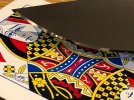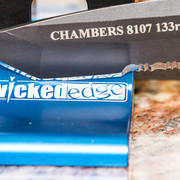Issues like that are commonly seen on blades with less-than-perfect symmetry of the primary grind; they're almost never perfect in production knives especially. Very common near the tip. More complex grinds with more 'facets' in them, like swedges, sabre grinds, flat near spine, hollow near the edge, etc, will more easily show asymmetry of the primary grind, comparing one side to the other when viewing the blade from the tip end (tip pointed directly toward your eye).
In the 4th photo in the OP, showing the spine view, I see a little bit of deflection of the tip toward the lower side of the handle. Maybe a slightly bent/warped tip, or maybe it's ground that way. At any rate, it shows there's at least some asymmetry near the tip of the blade. If that's off, the angles for sharpening will be a little different from each side, when clamped in the guide. The thickness of each side relative to the centerline of the grind (from spine's center to the apex of the cutting edge) often varies from side to side as well, which can also create these problems. The thicker side will show wider bevels, even if the sharpening angle relative to the centerline happens to be the same on both sides.




















